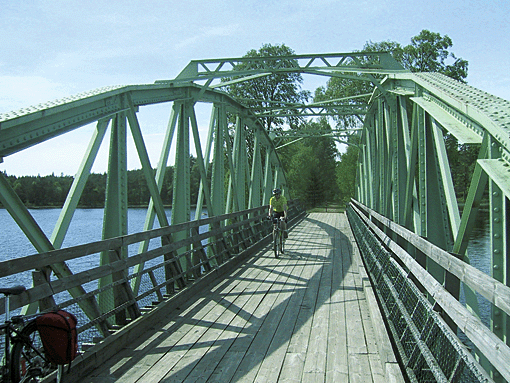The Enbankment Cycle Way’s Enbankments

Sweden once had a well-woven railway network. The navvies worked hard during the second half of the 19th century, and railways are still being built today.
However, people move, the supply of raw materials from different ore deposits dries up, the demand for certain products diminishes, and the competition everywhere these days is murderous. Small communities and sometimes whole districts disappear, and with them, of course, go existing railways.
Of Sweden’s extensive railway network (17,500 km) in the 1930s, 6,000km has been closed down. Of this track, some has been ploughed up, some close to built-up areas has become roads and cycle-paths, some shorter stretches are run as museum and inspection-trolley railways, whilst the majority is simply overgrown.
The rails on a closed-down railway cannot be torn up for three years, and a few railways remain just for goods traffic. But after this period, anyone can buy a piece from the Traffic Authority. If there are no would-be buyers, the land is eventually returned to its former owner.
It is parts of this natural resource that SCS would like to make use of, by building cycle paths. To restore a completely overgrown railway embankment is expensive. We estimate it will cost 30-40 million Swedish krona to fully restore the Embankment Way.
Not all closed-down railways are interesting from a tourist perspective. They were, after all, closed down because the people had moved away, the local services discontinued, and the areas grown over. Hardly something to attract tourists. Nor are dead straight stretches through monotonous countryside something to increase visitor frequency. There are in fact very few closed-down railways with any chance of being attractive and ”profitable” from the point of view of tourism.
Banvallsleden (Halmstad–Ljungby–Karlshamn) is a shining exception. All embankments are easy to cycle on, this is a normal advantage, but here the embankment goes through beautiful and varied terrain the whole time. The villages remain, and several stations are still intact. It gives a good impression when the name of the village can still be read on the façade of the station buildings. In several places even the signals, platforms and goods sheds have been preserved. Nor have the local facilities disappeared. On the contrary, several districts are prospering, and are full of ideas and optimism.
The scenery is magnificent, with vast oak and beech forests, nature reserves, flowing watercourses, and large lakes. Simlångsdalen is famous for its beauty, and the route crosses several big rivers, following Mörrumsån for many miles – possibly the best salmon-fishing waters in the world. The lakes Bolmen and Åsnen are impressive, and other things well worth seeing can be found amongst all of this – mills and estates, castles and manors, splendid ancient relics, and modern attractions.
After the miles-long sandy beaches of Laholmsbukten come Fylleån’s dramatic rapids, Finnveden’s beautiful marshes, and Sunnerbo’s (Sagobygden’s) varied and civilised countryside – genuine Småland. It is true that the forest has somewhat taken over in recent years, but the numerous watercourses provide relief. And these are industrious people who don’t give up easily.
Towards Vislanda the terrain opens up again, and you can see the horizon across lakes Salen and Åsnen before diving deep into Sweden’s garden past Hemsjö, Svängsta and Asarum. Did we forget to mention Banvallsleden’s three metropolises – Halmstad, Ljungby and Karlshamn? You can read more about them later in this booklet.
